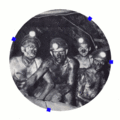User:Manetta/i-could-have-written-that/from-mining-minerals-to-mining-data: Difference between revisions
No edit summary |
|||
| Line 50: | Line 50: | ||
===terminology=== | ===terminology=== | ||
* artefacts | * artefacts | ||
* archeological complex | * archeological complex (multiple artefacts on same location) | ||
* monument (valuable complex(es)) | |||
===Archis database=== | ===Archis database=== | ||
Revision as of 18:43, 12 January 2016
mining
what does it mean?
what is meant with it?
'mining' differences
| mining minerals | mining data |
|---|---|
| natural resource | not natural resource |
| non-renewable | constantly renewed |
| mineral = product | data = cultural by-product |
| to mine = to extract | to mine = to derive |
from: mining minerals
Mining is required to obtain any material that cannot be grown through agricultural processes, or created artificially in a laboratory or factory. Mining in a wider sense includes extraction of any non-renewable resource such as petroleum, natural gas, or even water.
Mining operations usually create a negative environmental impact, both during the mining activity and after the mine has closed.
Mineral processing (or mineral dressing) is a specialized area in the science of metallurgy that studies the mechanical means of crushing, grinding, and washing that enable the separation (extractive metallurgy) of valuable metals or minerals from their gangue (waste material).
from: Wikipedia (5th Jan. 2016)
Products that make modern life work. (...) Our major products are aluminium, copper, diamonds, gold, industrial minerals (borates, titanium dioxide and salt), iron ore, thermal and metallurgical coal and uranium.
notes
creating value out of material that used to belong to nobody
analogy to regulations of the amount of oxygen
via: archeology
If data mining could be regarded as 'digging for information' there is a close connection between data mining and archeology, where archeologists search for artefacts that could offer information about the human activities on that location in the past.
archeology activities
In the Netherlands there is an official guideline called 'KNA' that commercial, scientific and governmental archeologists need to follow in order to deliver research that complies to the basic qualities. (KNA's table of content)'KNA' stands for 'Dutch Qualitynorm for Archeology'. It contains protocols for desk research, writing a program of requirements, exploratory field research for test trenches, excavation fieldwork, the physical protection of the sites, specialist research, archaeological supervision of construction works, and the registration plus management of the findings. (KNA, 2016)
terminology
- artefacts
- archeological complex (multiple artefacts on same location)
- monument (valuable complex(es))
Archis database
Archis is the Dutch national database for archeological information contains multiple types of informations:
- data model of what has been captured, how, and how data relates to other data
- area's of research
- observations
- artefacts
- complexes
- monuments (valuable complexes)
- value of archeological complex (according to provincial and national government)
- filter for differences in observation quality related to the probability of the presence of an archeological complex*
- quality evaluation of the observation files
* Wiemer gives an example of a location description: 1/2 hours walk in south-east direction starting at the church of .... (Wiemer, 2002)
standards
Standardisation is the main instrument for managing quality. (Simons, 1994) In archeology standardization is not only important for high quality and clean databases, also the quality of definitions, thesauri, processes and procedures are relying on an active management of standards. (Wiemer, 2002)
to: mining data
computer science
data science
data as resource
- Google books as fuel for information control (and data-extraction? → speculation...), tightening corporate control over information; Appellate Court Ruling For Google Books: Fair Use, or Anti-Democratic Preemption?;
history of 'data mining' as term
appearances:
60s
90s - 20??
- Yahoo Groups mailinglist for the Stanford Data Mining group, first message from 30th Oct. 1997; Sergey Brin + Jeff Ullman + Howard Ho + George H. John + Pat Langley; (list of first messages, 1997), (group overview, 2002), (group overview, 2008)
- journal started in 1997, Data Mining and Knowledge Discovery; (overview of issues, 1997 - now)
- MIT thesis; ParaSite: Mining Structural Information on the Web, by Ellen Spertus; (paper, Feb. 1997/8) [also the name of] The Sixth International WWW Conference (WWW 97). Santa Clara, USA, April 7-11, 1997. (reference from Brin + Page, 1998) Also appearing in Computer Networks and ISDN Systems: The International Journal of Computer and Telecommunications Networking 29 (1997) 1205-1215.
- Stanford research paper presenting Google, The Anatomy of a Large-Scale Hypertextual Web Search Engine, by Sergey Brin + Lawrence Page (paper html, 1998), (paper pdf, 1998)
- research paper by Sergey Brin on Nearest Neighbours; (paper, 2005)
notes
no ne

